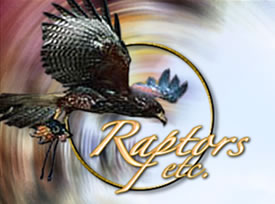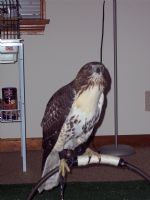Red tailed Hawks for Sale
No Red-tailed Hawks currently listed for placement
Red-tailed Hawk
The Red-tailed Hawk (Buteo jamaicensis) is a medium-sized bird of prey, one of three species colloquially known in the United States as the "chicken hawk," though it rarely preys on chickens. It breeds almost throughout North America from western Alaska and northern Canada to as far south as Panama and the West Indies, and is one of the most common buteos in North America. There are fourteen recognized subspecies, which vary in appearance and range. It is one of the largest members of the genus Buteo in North America, typically weighing from 690 to 1600 grams (1.5 to 3.5 pounds) and measuring 45-65 cm (18 to 26 in) in length, with a wingspan from 110 to 145 cm (43 to 57 in). The Red-tailed Hawk displays sexual dimorphism in size, as females are about 25% heavier than males.The Red-tailed Hawk occupies a wide range of habitats and altitudes, including deserts, grasslands, coniferous and deciduous forests, tropical rainforests, agricultural fields and urban areas. It lives throughout the North American continent, except in areas of unbroken forest or the high arctic. It is legally protected in Canada, Mexico and the United States by the Migratory Bird Treaty Act.
Because they are so common and easily trained as capable hunters, the majority of hawks captured for falconry in the United States are Red-tails. Falconers are permitted to take only hawks in their first year. Adults, which may be bred, are not permitted to be taken for falconry. Falconers prefer to train first year hawks, which have not been locked into uncooperative adult behaviors.
A male Red-tailed Hawk may weigh from 690 to 1300 grams (1.5 to 3.5 pounds) and measure 45-56 cm (18 to 22 in), while a female can weigh between 900 and 2000 grams (2 and 4.4 pounds) and measure 50-65 cm (20 to 26 in) in length. As is the case with many raptors the Red-tailed Hawk displays sexual dimorphism in size, as females are 25% larger than males. The wingspan is from 110 to 145 cm (43 to 57 in).
Red-tailed Hawk plumage can be variable, depending on the subspecies and the region. These color variations are morphs, and are not related to molting.
The western North American population, is the most variable subspecies and has three color morphs: light, dark, and intermediate or Rufus. The dark and intermediate morphs constitute 10-20% of the population.
Though the markings and hue vary, the basic appearance of the Red-tailed Hawk is consistent. The underbelly is lighter than the back and a dark brown band across the belly, formed by vertical streaks in feather patterning, is present in most color variations. The red tail, which gives this species its name, is uniformly brick-red above and pink below. The bill is short and dark, in the hooked shape characteristic of raptors. The cere, the legs, and the feet of the Red-tailed Hawk are all yellow.
Immature birds can be readily identified at close range by their yellowish irises. As the bird attains full maturity over the course of 3-4 years, the iris slowly darkens into a reddish-brown hue. In both the light and dark morphs, the tail of the immature Red-tailed Hawk are patterned with numerous darker bars.
Use in falconry
The Red-tailed Hawk is a popular bird in falconry, particularly in America where the sport of falconry is tightly regulated at the federal and state levels. There are fewer than 4,000 falconers in the United States, therefore any effect on the Red-tailed Hawk population, estimated to be approximately one million in the United States, is statistically insignificant.
The Red-tailed Hawk is adaptable and useful in modern falconry. It is a powerful and sturdy falconry bird best flown at larger ground quarry such as squirrels, rabbits, and jackrabbits. Occasionally, the Red-tailed Hawk may even take a pigeon, crow, or duck.





 Trapped 8/1/09
Trapped 8/1/09